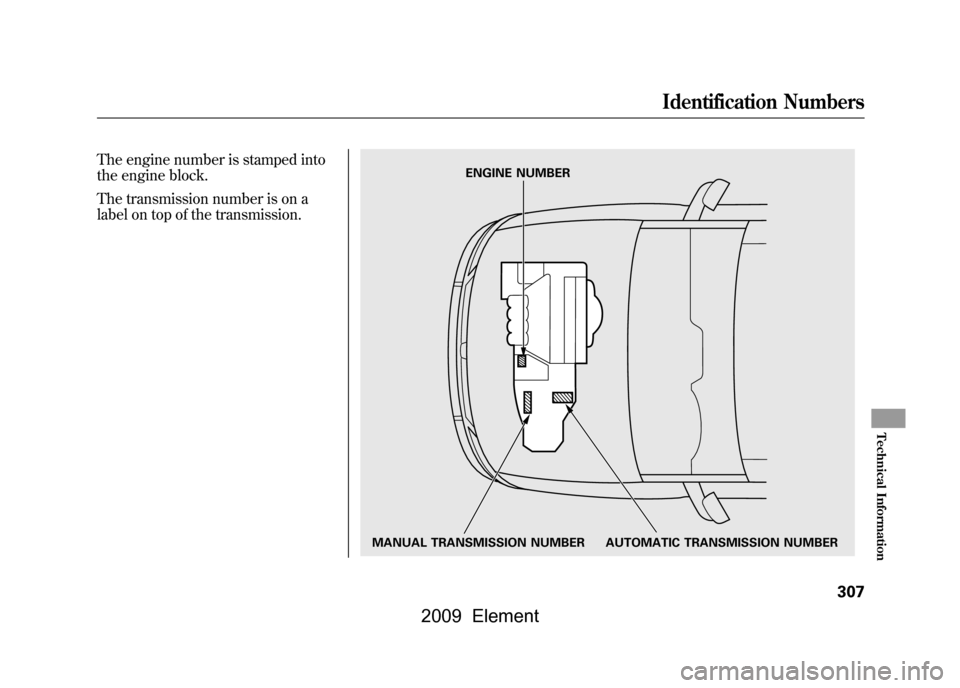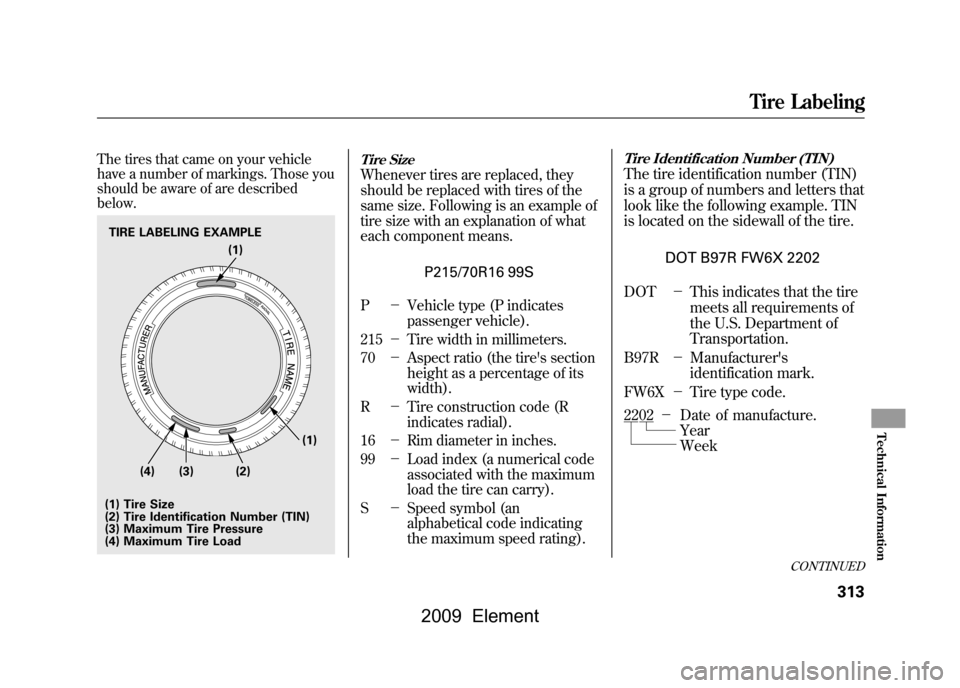HONDA ELEMENT 2009 1.G Owners Manual
Manufacturer: HONDA, Model Year: 2009, Model line: ELEMENT, Model: HONDA ELEMENT 2009 1.GPages: 345, PDF Size: 18.9 MB
Page 311 of 345

The engine number is stamped into
the engine block.
The transmission number is on a
label on top of the transmission.
MANUAL TRANSMISSION NUMBER AUTOMATICTRANSMISSION NUMBER
ENGINE NUMBER
Identification Numbers
307
Technical Information
2009 Element
Page 312 of 345

DimensionsLength 169.9 in (4,316 mm)
ꭧ1ꭧ 2
170.4 in (4,328 mm)
ꭧ 3
Width 71.6 in (1,819 mm)
Height 70.4 in (1,788 mm)
ꭧ1,ꭧ 2
69.6 in (1,768 mm)
ꭧ3
Wheelbase 101.4 in (2,575 mm)
Track Front 62.1 in (1,577 mm)
ꭧ1,ꭧ 2
62.1 in (1,578 mm)
ꭧ3
Rear 62.3 in (1,582 mm)
ꭧ1,ꭧ 2
62.5 in (1,587 mm)
ꭧ3
Weights
Gross vehicle weight rating See the certification label attached
to the driver's doorjamb (front edge
of rear door). Seating Capacities
Total 4
Front 2
Rear 2
Engine Type Water cooled 4-stroke DOHC
i-VTEC 4-cylinder gasoline engine
Bore x Stroke 3.43 x 3.90 in (87.0 x 99.0 mm)
Displacement 144 cu-in (2,354 cm
3)
Compression ratio 9.7 : 1
Spark plugs NGK: IZFR6K-11
DENSO: SKJ20DR-M11
ꭧ 1: LX model
ꭧ 2: EX model
ꭧ 3: SC model
Specifications308
2009 Element
Page 313 of 345

CapacitiesFuel tank Approx.
15.9 US gal (60 L)
Engine oil Change
ꭧ 1
Including filter 4.4 US qt (4.2 L)
Without filter 4.2 US qt (4.0 L)
Total 5.6 US qt (5.3 L)
Capacities
Engine
coolant Automatic
Transmission
Change
ꭧ2
1.35 US gal (5.1 L)
Total 1.90 US gal (7.2 L)
Manual
Transmission Change
ꭧ2
1.37 US gal (5.2 L)
Total 1.93 US gal (7.3 L)
Automatic
transmission
fluid Change
4WD 2.6 US qt (2.5 L)
2WD 2.7 US qt (2.6 L)
Total 4WD 7.6 US qt (7.2 L)
2WD 7.4 US qt (7.0 L)
Manual
transmission
fluid Change
2.0 US qt (1.9 L)
Total
4WD 2.4 US qt (2.3 L)
2WD 2.3 US qt (2.2 L)
Rear
differential
fluid (4WD) Change
1.1 US qt (1.0 L)
Total 1.3 US qt (1.2 L)
Windshield washer reservoir 4.8 US qt (4.5 L)
ꭧ1: Excluding the oil remaining in the engine
ꭧ2: Including the coolant in the reserve tank and that remaining in the engine
Reserve tank capacity:
0.15 US gal (0.55 L)
Specifications
309
Technical Information
2009 Element
Page 314 of 345

Air ConditioningRefrigerant type HFC-134a (R-134a)
Charge quantity 17.6-19.4 oz (500 -550 g)
Lubricant type ND-OIL8
Lights Headlights 12 V-60/55 W (H4/HB2)
Daytime running lights 12 V-60 W (HB3)
Front turn signal/parking lights 12 V -27/8 W (Amber)
Front side marker lights 12 V-3CP
Side turn signal lights 12 V-3CP
Rear turn signal lights 12 V-21 W (Amber)
Rear side marker lights 12 V-3CP
Brake/Taillights 12 V-21/5 W
Back-up lights 12 V-21CP
License plate lights 12 V-5W
Ceiling light 12 V-8W
ꭧ1
12 V -5W
ꭧ2, ꭧ3
Spotlights 12 V-8W
ꭧ2, ꭧ3
Cargo area light 12 V-8W
High-mount brake light 12 V-21 W
Battery Capacity 12 V-47 AH/20 HR
12 V -38 AH/5 HR Fuses
Interior See page301or the fuse label
attached to the inside of the fuse
box door under the steering
column.
Under-hood See page302or the fuse box cover.
Alignment Toe-in Front 0.0 in (0 mm)
Rear 0.08 in (2.0 mm)
Camber Front -0°13 ’
ꭧ1, ꭧ2
- 0°24 ’
ꭧ3
Rear -1°00 ’
ꭧ1, ꭧ2
- 1°06 ’
ꭧ3
Caster Front 1°50’
Tires Size Front/Rear P215/70R16 99S
ꭧ1, ꭧ2
P225/55R18 97H
ꭧ3
Pressure Front 33 psi (230 kPa, 2.3 kgf/cm
2)ꭧ1, ꭧ2
32 psi (220 kPa, 2.2 kgf/cm
2)ꭧ3
Rear 35 psi (240 kPa, 2.4 kgf/cm
2)ꭧ1, ꭧ2
32 psi (220 kPa, 2.2 kgf/cm
2)ꭧ3
Spare 60 psi (420 kPa, 4.2 kgf/cm
2)
ꭧ 1: LX model
ꭧ 2: EX model
ꭧ 3: SC model
Specifications310
2009 Element
Page 315 of 345

The tires on your vehicle meet all
U.S. Federal Safety Requirements.
All tires are also graded for
treadwear, traction, and temperature
performance according to
Department of Transportation (DOT)
standards. The following explains
these gradings.
Uniform Tire Quality Grading
Quality grades can be found where
applicable on the tire sidewall
between tread shoulder and
maximum section width. For
example:Treadwear 200
Traction AA
Temperature A
All passenger car tires must conform
to Federal Safety Requirements in
addition to these grades. Treadwear
The treadwear grade is a
comparative rating based on the wear
rate of the tire when tested under
controlled conditions on a specified
government test course. For
example, a tire graded 150 would
wear one and one-half (1 1/2) times
as well on the government course as
a tire graded 100. The relative
performance of tires depends upon
the actual conditions of their use,
however, and may depart
significantly from the norm due to
variations in driving habits, service
practices and differences in road
characteristics and climate.
Traction
The traction grades, from highest to
lowest, are AA, A, B, and C. Those
grades represent the tire's ability to
stop on wet pavement as measured
under controlled conditions on
specified government test surfaces of
asphalt and concrete. A tire marked
C may have poor traction
performance.
Warning: The traction grade
assigned to this tire is based on
straight-ahead braking traction tests,
and does not include acceleration,
cornering, hydroplaning, or peak
traction characteristics.
DOT Tire Quality Grading (U.S. Vehicles)
311
Technical Information
2009 Element
Page 316 of 345

Temperature
The temperature grades are A (the
highest), B, and C, representing the
tire's resistance to the generation of
heat and its ability to dissipate heat
when tested under controlled
conditions on a specified indoor
laboratory test wheel. Sustained high
temperature can cause the material
of the tire to degenerate and reduce
tire life, and excessive temperature
can lead to sudden tire failure. The
grade C corresponds to a level of
performance which all passenger car
tires must meet under the Federal
Motor Vehicle Safety Standard No.
109. Grades B and A represent
higher levels of performance on the
laboratory test wheel than the
minimum required by law.Warning: The temperature grade for
this tire is established for a tire that
is properly inflated and not
overloaded. Excessive speed,
underinflation, or excessive loading,
either separately or in combination,
can cause heat buildup and possible
tire failure.DOT Tire Quality Grading (U.S. Vehicles)312
2009 Element
Page 317 of 345

The tires that came on your vehicle
have a number of markings. Those you
should be aware of are described
below.
Tire SizeWhenever tires are replaced, they
should be replaced with tires of the
same size. Following is an example of
tire size with an explanation of what
each component means.P215/70R16 99S
P -Vehicle type (P indicates
passenger vehicle).
215 -Tire width in millimeters.
70 -Aspect ratio (the tire's section
height as a percentage of its
width).
R -Tire construction code (R
indicates radial).
16 -Rim diameter in inches.
99 -Load index (a numerical code
associated with the maximum
load the tire can carry).
S -Speed symbol (an
alphabetical code indicating
the maximum speed rating).
Tire Identification Number (TIN)The tire identification number (TIN)
is a group of numbers and letters that
look like the following example. TIN
is located on the sidewall of the tire.
DOT B97R FW6X 2202
DOT -This indicates that the tire
meets all requirements of
the U.S. Department of
Transportation.
B97R -Manufacturer's
identification mark.
FW6X -Tire type code.
TIRE LABELING EXAMPLE
(1) Tire Size
(2) Tire Identification Number (TIN)
(3) Maximum Tire Pressure
(4) Maximum Tire Load (1)
(2) (1)
(3)(4)
2202 -
Year
Week
Date of manufacture.
CONTINUED
Tire Labeling
313
Technical Information
2009 Element
Page 318 of 345

Maximum Tire PressureMax Press-The maximum air
pressure the tire can
hold.Maximum Tire LoadMax Load -The maximum load the
tire can carry at
maximum air pressure. Tire Pressure Monitoring System
(TPMS)
Each tire, including the spare (if
provided), should be checked
monthly when cold and inflated to
the inflation pressure recommended
by the vehicle manufacturer on the
vehicle placard or tire inflation
pressure label.
(If your vehicle has tires of a different
size than the size indicated on the
vehicle placard or tire inflation
pressure label, you should determine
the proper tire inflation pressure for
those tires.) As an added safety feature, your
vehicle has been equipped with a tire
pressure monitoring system (TPMS)
that illuminates a low tire pressure
telltale
when one or more of your tires is
significantly under-inflated.
Accordingly, when the low tire
pressure telltale illuminates, you
should stop and check your tires as
soon as possible, and inflate them to
the proper pressure.
Tire Labeling, Tire Pressure Monitoring System (TPMS)
-Required Federal Explanation314
2009 Element
Page 319 of 345

Driving on a significantly under-
inflated tire causes the tire to
overheat and can lead to tire failure.
Under-inflation also reduces fuel
efficiency and tire tread life, and may
affect the vehicle's handling and
stopping ability.
Please note that the TPMS is not a
substitute for proper tire
maintenance, and it is the driver's
responsibility to maintain correct tire
pressure, even if under-inflation has
not reached the level to trigger
illumination of the TPMS low tire
pressure telltale.Your vehicle has also been equipped
with a TPMS malfunction indicator to
indicate when the system is not
operating properly. The TPMS
malfunction indicator is provided by
a separate telltale, which displays the
symbol
‘‘TPMS ’’when illuminated.
When the malfunction indicator is
illuminated,
the system may not be able to detect
or signal low tire pressure as
intended.
TPMS malfunctions may occur for a
variety of reasons, including the
installation of replacement or
alternate tires or wheels on the
vehicle that prevent the TPMS from
functioning properly. Always check the TPMS malfunction
telltale after replacing one or more
tires or wheels on your vehicle to
ensure that the replacement or
alternate tires and wheels allow the
TPMS to continue to function
properly.
Tire Pressure Monitoring System (TPMS)
-Required Federal Explanation
315
Technical Information
2009 Element
Page 320 of 345

The burning of gasoline in your
vehicle's engine produces several by-
products. Some of these are carbon
monoxide (CO), oxides of nitrogen
(NOx), and hydrocarbons (HC).
Gasoline evaporating from the tank
also produces hydrocarbons.
Controlling the production of NOx,
CO, and HC is important to the
environment. Under certain
conditions of sunlight and climate,
NOx and HC react to form
photochemical‘‘smog. ’’Carbon
monoxide does not contribute to
smog creation, but it is a poisonous
gas. The Clean Air Act
The United States Clean Air Act
ꭧsets
standards for automobile emissions. It
also requires that automobile
manufacturers explain to owners how
their emissions controls work and
what to do to maintain them. This
section summarizes how the
emissions controls work.
ꭧIn Canada, Honda vehicles comply
with the Canadian emission
requirements, as specified in an
agreement with Environment Canada,
at the time they are manufactured.Crankcase Emissions Control
SystemYour vehicle has a positive crankcase
ventilation system. This keeps gasses
that build up in the engine's crankcase
from going into the atmosphere. The
positive crankcase ventilation valve
routes them from the crankcase back
to the intake manifold. They are then
drawn into the engine and burned.
Evaporative Emissions Control
System
As gasoline evaporates in the fuel
tank, an evaporative emissions
control canister filled with charcoal
adsorbs the vapor. It is stored in this
canister while the engine is off. After
the engine is started and warmed up,
the vapor is drawn into the engine
and burned during driving.
Onboard Refueling Vapor
Recovery
The onboard refueling vapor
recovery (ORVR) system captures
the fuel vapors during refueling. The
vapors are adsorbed in a canister
filled with activated carbon. While
driving, the fuel vapors are drawn
into the engine and burned off.
Emissions Controls316
2009 Element